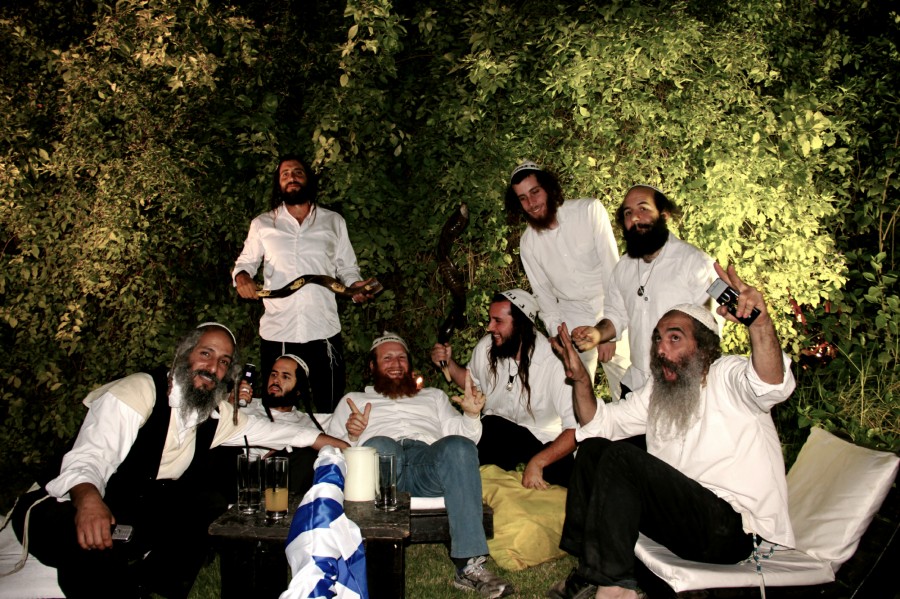Natan Gabbay takes a gulp of clear liquor and warms up on his shofar, the ram’s horn trumpet that is sacred in Judaism. He’s a member of a whimsical Orthodox sect known as Na Nach. Tonight, about a dozen Na Nachs have been hired as an entertainment act for a fancy wedding outside Tel Aviv. It’s a surprise — the guests have no idea what’s in store for them.
“We barge in, all of us together, and start to dance with them,” Gabbay says. “The people in the wedding will see a different kind of happiness. This is happiness with holiness, together.”
They slip the DJ a special CD of their music. Suddenly, a dozen young men with big beards, stiff dress clothes and long, curling sidelocks rush the dance floor.
Electronic dance tracks begin to pump from the speakers, and the Na Nachs jump around like teenagers at a music festival. With heavy bass drums and hard-edged synthesizers, the soundtrack isn’t much different from those of the wild trance parties Israel is famous for — save for the lyrics, which all concern God and the Torah. The religious themes don’t stop the secular wedding guests from joining in and having a good time. After 15 minutes, the Na Nachs rush out as suddenly as they came, leaving big grins on everyone’s faces.
Na Nachs make merry at weddings for money, but they’re more than a novelty act. They’re a growing religious movement with a distinct vision of ultra-Orthodox Judaism.
Na Nach took off about 30 years ago as a countercultural offshoot of the Breslovers, a Hasidic sect that follows the mystical writings of 19th-century Ukrainian rabbi Nachman of Breslov. Their central belief is that happiness is key to a rich relationship with God, and that it’s their spiritual duty — a mitzvah — to spread that happiness to others.
“Rabbi Nachman says that when you’re happy, you keep the Torah better,” says Zohar Ginsberg, a 24-year-old member of the sect. “So you have to do whatever you can to be happy. Dance. Sing. Jokes. Nonsense.”
For the Na Nachs, dancing to electronic music is actually a matter of the soul. That appealed to Ginsberg: He grew up in a religious family, but found himself slipping away from Judaism as a teenager. When he came across Nachman’s teachings, it was a revelation.
“You have to find a way to connect with love,” Ginsberg says, “not to feel like it’s just a bunch of rules that you do and it makes your life better. You want to feel like it’s something that gives you liveliness and happiness.”
In a sense, the Na Nach are very traditional. They keep strict religious rules about diet and modesty, for example. But in most other ways, their religious style diverges from other Hasidic groups. Shaul Magid, a scholar of Hasidic Judaism from the University of Indiana, says while most Orthodox movements focus on reading and studying, the Na Nachs are more interested in having intense, personal and ecstatic experiences with God.
“Prayer, joy, celebration: This becomes the core of religious living for the Na Nach,” Magid says.
The Na Nachs’ interest in dancing and ecstatic experiences leads Magid to compare them to another subculture: ravers.
“Rave culture is very big in Israel,” Magid says. “And in some way the Na Nach people are replicating a particular certain kind of rave culture within the norms of ultra-Orthodox Judaism.”
The group has attracted lots of younger Israelis who grew up in secular families and find themselves interested in Orthodox Judaism. In fact, many of them are former ravers who decided to trade in the party life for a more spiritual lifestyle.
Those rave culture roots show themselves in the Na Nachs’ famous joyrides that happen every week in cities all over Israel. A few days after the wedding, Zohar Ginsberg and his buddies pile into a colorful van covered in stickers and drive through Jerusalem’s curvy streets, blasting music from a speaker system strapped to the roof. They play house and trance music, but also Torah-themed reggae, rock and even mizrahi (“Eastern” pop).
“Hopefully people will get a little happy when we pass by,” Ginsberg says, “and they’ll get the light of Rabbi Nachman.”
At red lights, the Na Nachs jump out and dance around in the intersections, bringing an instant, religious-tinged rave party wherever they go. What’s more remarkable is what happens next: Some pedestrians drop whatever they are doing for a few moments and dance along.
“I just felt acceptance and welcoming. And love,” says Gabriella Wernick, a passerby who found the good vibes to be contagious.
Secular Jews like Wernick often like the Na Nachs. Magid thinks that’s extraordinary when you consider that tensions are high between secular and religious Israelis.
“The Na Nachs are really just interested in proselytizing joy,” Magid says. “So in that sense, they’re really a breath of fresh air for a lot of the secular Jews. They allow for a certain kind of exposure to traditional Judaism that secular Jews would never have because they would never have that sort of contact with the ultra-Orthodox community.”
Magid thinks the Na Nachs are helping to create some understanding between the two groups. Still, Ginsberg feels that his movement is often misunderstood: “A lot of people think we’re crazy. Some people think we use drugs. But the truth is almost none of the Na Nachs use drugs. We’re just happy from Rabbi Nachman himself. He gives us the power to dance in the streets.”
Fellow Na Nach Gabbay, however, doesn’t mind if you call him crazy.
“We prefer to be crazy in happiness than normal and sad,” Gabbay says. “Being Na Nach opens your heart. It makes you feel free.”
Shira Bannerman contributed reporting and production to this piece.
9(MDAxNzk1MDc4MDEyMTU0NTY4ODBlNmE3Yw001))


